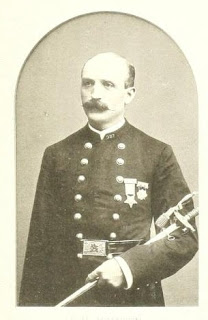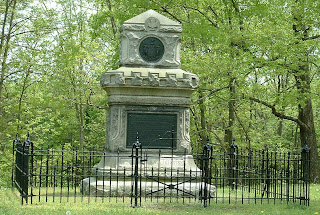BREVET MAJOR GEORGE F. TAIT.
Past Commander of U. S. Grant Post 327, G. A. R.
Personal courage and reckless daring are conspicuous traits in the Irish character, and there is scarcely a little field in the world’s history in which the sons of Erin have not distinguished themselves by their gallantry and deeds of daring.
The men of the Tenth New York, as seen in 1861.
Major Tait, the subject of this sketch, was born in Ireland on May 13th, 1837. He came with his parents to America in childhood. His educational advantages were exceedingly limited, but faithfully improved. He served twelve years in the publishing house of Harper Bros., and during a portion of the time attended night school, and thus laid the foundation for his subsequent success in life.
The regimental battle flag of the Tenth New York.
In 1858 he joined the “Lindsey Blues,” an independent company noted for its efficiency in military drill. He thus acquired a sufficient knowledge of the manual of arms to fit him for service in the ranks of the Union Army, and to this, as well as to his personal courage and daring, is due the rapid advancement which followed.
On April 26th, 1861, he enlisted as private in Company H, Tenth New York Volunteers, known as the “National Zouaves.” He was soon after made Sergeant, and after the battle of Big Bethel, in which he participated, he was commissioned Second Lieutenant of Company K, and subsequently promoted First Lieutenant. The following is the official record of his services, signed by Geo. F. Hooper, Lieutenant-Colonel commanding Tenth New York Volunteers:
The period for which the regiment had enlisted having expired on April 16th 1863, Lieutenant Tait remained to serve with the Battalion for the unexpired term of the three years’ men. He was at once promoted to the Captaincy of Company B, and continued to hold that rank until his honorable discharge, August 16th, 1864. During his term of office he was Division Provost Marshal for four months in Brigadier-General Alex. Hayes’ Division, Second Corps, and was placed in command, by special order, of the Delaware Battalion of Volunteers for more than a month. He has participated in the following engagements, viz.: Big Bethel, capture of Norfolk, Mechanicsville, Gaines’ Hill (“Gaines’ Mill”), Seven Days’ Battles, Second Bull Run, South Mountain, Antietam, Shepardstown Ford, Fredericksburg, Chancellorsville, Gettysburg, Auburn, Bristow Station, Centreville, Mine Run, Morton’s Ford and Wilderness. At the last named battle he received a wound in his left leg, necessitating amputation. He was also wounded at Gaines’ Hill, Fredericksburg and Bristow Station. He was honorably discharged August 16th, 1864, on surgeon’s certificate of disability. He was brevetted Major August 3rd, 1866, for gallant and meritorious conduct on the field and during the war.
His several comrades-in-arms, who are still living, bear witness to his gallantry in action.
A monument to the Tenth New York on the Manassas battlefield, Virginia.
Captain Tait married his wife. Miss Kate E. Barry, of Philadelphia, on June 3d, 1863, while on an eight days’ furlough. Six children have been born to them; three have “crossed the dark river to the portals beyond;” three are still living, viz.: George F., Jr., Willie C. and Harry R. When “this cruel war was over” Major Tait returned to Brooklyn, and in 1866 he received the appointment of Inspector in the New York Custom House, and continues to fill that position.
Major Tait was one of the pioneers in the G.A.R. of New York State. He first joined Wadsworth Post, No. 4, of Brooklyn, since disbanded. He afterwards joined Rankin Post, No. 10, and in 1882 withdrew with a number of others and organized Post 327. He was its first Senior Vice-Commander, and in 1883 was elected Commander, lie served on the staff of Commander-in-Chief William Ernshaw in 1879, and on the staff of Department Commander Abram Merrit in 1881. He is at present Aide-de-Camp on the staff of Department Commander H. Clay Hall.
Henry Whittemore, History of U.S. Grant Post, No. 327, Brooklyn, N.Y., Including Biographical Sketches of Its Members (Detroit: Detroit Free Press, 1885).
A soldier of the Tenth New York in the distinctive Zouave uniform worn early in the war.
NOTE
The Grand Army of the Republic (G.A.R.), founded in 1866, was a Civil War veterans’ organization. By 1890, it had some 500,000 members nationwide. (Five Presidents were members.) Many Catholic bishops were initially wary of its initiation ritual which smacked too closely of Freemasonry for their tastes. (The Church had condemned Freemasonry in the 1700’s.) In many churches, including some in Brooklyn, G.A.R. members were banned if they wore their badges.
By the 1890’s, however, the ban was lifted, and Catholics were officially allowed to participate in the G.A.R. (There had been a few scattered attempts to start specifically Catholic groups, in Albany and at Most Holy Trinity, a German parish in Brooklyn, but these didn’t last very long. ) Beginning in the early 1890’s, special Masses were celebrated annually at Brooklyn churches in conjunction with Memorial Day.
An 1894 Brooklyn Eagle article stated: “The Catholic veterans are now numerous in Rankin, Mansfield, Frank Head, Dupont, Dakin, Abel Smith, Stevenson and other posts of the Grand Army of the Republic.” As noted above, Major Tait originally belonged to the Rankin post. In 1873, he ran for the state assembly, but was defeated, due in large part to a local group called “The Order of the American Union,” whose members pledged not to vote for Catholics.
Major Tait died on May 30, 1919, in his home at 778 Prospect Place, Brooklyn. A wake was held for him at the U.S. Grant Post 327, located at 489 Washington Avenue. A Requiem Mass was celebrated at St. Teresa of Avila Church on Classon Avenue in Brooklyn’s Prospect Heights section. He was buried at Holy Cross Cemetery in Flatbush.
St. Teresa of Avila Church was founded in Brooklyn’s Prospect Heights section in 1874 for a growing Irish immigrant population. Major Tait’s funeral Mass was celebrated here in 1919.
A final note should be made of two terms used in the above text. A “brevet” is a temporary wartime rank awarded for bravery. During the Civil War they were often awarded in place of medals. (At the time, the United States Army only had one medal, the Congressional Medal of Honor.) The term “zouave” refers to a unit of elite troops in the French army that was was created in North Africa in the 1830’s. They wore a colorful uniform whose main feature was red baggy pants. Many units of soldiers North and South wore them, but in many cases they were abandoned for more practical garb.

















